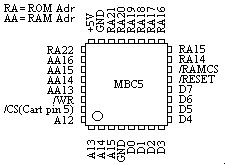The Nintendo Gameboy uses a Memory Bank Controller inside of official cartridges for switching between banks of memory and ultimately expanding the addressable memory. The MBC will switch between banks of both ROM and RAM so that the programmer may code larger games and backup more data in save files.
There are four main MBC's numbered 1 through 5 and excluding 4. The reason I am writing this is because each following revision did not simply add more addressable memory. Each one has unique capabilities built in as well as expanding the addressable memory. in general the MBC's function by waiting for specific data bits to be written to yet more specific memory locations. Once the data in question is written to the specific memory location, the MBC switches the active bank of ROM and RAM to accommodate more code.
I will summarize each MBC as well as quote some information from datasheets.
MBC1

Is the first in the series of controllers which did only expand the addressable memory. Since the gameboy has 16 address pins and 8 data pins running through to the cartridge, the gameboy may without an MBC address only read from and write to a maximum of 256Kbits or 32Kbytes which is incredibly small considering Mario Land has 12 massive levels with multiple means of gameplay including the platformer and shooter, in both an airplane and submarine. Some of these levels even have secondary underworlds where Mario drops to an extra map off screen to collect secret coins or other items.
In any case, the MBC1 has two different modes to choose from. There is the 16Mbit ROM/8KByte RAM and 4Mbit ROM/32KByte RAM.
Note: RAM is an external IC which needs to be connected to a battery while disconnected from gameboy power to retain data.
MBC2
Similarly to the MBC1, the MBC2 maps extra banks of memory with specific memory writes; however, it may only map up to 2Mbits or 256Kbytes of ROM. Why a decrease? Well the magical thing about the MBC2 is that it contains 512 x 4 bits of SRAM built into the IC itself. This saves a lot of room on your cartridge board granted you are designing one.
The MBC2 can save money on RAM and space on your board if you are programming a small game that requires little ROM and RAM. Referring to the MBC1 above, if you wanted to offer a saving feature, you would need to source a RAM IC as well and route all of the Address, data and control pins to another location on the board.
MBC3
The MBC3 may again address up to 16Mbits of memory, but has a major feature built like the MBC2 has RAM. The MBC3 has an RTC or Real Time Clock built in. The RTC while still needing battery power when disconnected, offers a real-time count so that games such as pokemon may tell whether it is night or day, or when an hour in real life has passed for example.
Some games use the MBC3 without utilizing the RTC, but games that do include Pokemon of Generation 2 and Harvest Moon.
MBC5
Lastly, the MBC5 is the final Memory Bank Controller from Nintendo. This particular MBC does not come with internal RAM or an RTC. It simply maps huge amounts of memory. It may map up to 64Mbits of ROM and up to 1Mbit of RAM but not both. There are different configurations to choose from; these are just the maximums.
This MBC which I find in nearly every Gameboy Color cartridge regardless of ROM size is guaranteed to work with the GBC's double speed mode. The others seem to work just fine too though, considering any GB game will run on your GBC.
For more information on how to use the MBC's with software, please refer to "Cartridge Types" in this document:
http://www.devrs.com/gb/files/gbspec.txt
MBC CPLD Clones & Reproductions
Aside from the Official Nintendo MBC's, people have had major success in recreating them using CPLD's. Both Homebrew developers and Chinese pirating companies that is.
Since the MBC2 and MBC3 contain separate ICs, recreating them is much too difficult for a single person. MBC1 and MBC5 on the other hand can and have been redesigned by using CPLD's. They way they work as mentioned above is that they look for specific data bytes to be written to specific address locations. This Logic can be entirely drawn out using logic gates, which in turn can be programmed onto the CPLD.
MBC1 - CPLD
The MBC1 being the most simple, can be drawn using as little as 11 gates! (granted you do not need RAM)
MBC5 - CPLD
The MBC5 is much more complex of course, but it has also been cloned successfully by at least two separate people using two different CPLD's. One person used the XC9536 and the other person used the XC9572.
XC9536
http://chipmusic.org/forums/topic/2988/mbc5-clone-in-cpld/
and XC9572
http://home1.stofanet.dk/hvaba/gameboy/mbc5cpld/cpldcart.html
Depending on the number of inputs and outputs, more complex logic ought to be designed using PLD's or CPLD's. Not only can you save money on IC's, but space on your circuit boards. More often than not, a logic IC will take up space on your board and have a handful of unused pins and gates which is wasteful and lazy.
As always, thanks for reading! I hope I opened someone's eyes to new and old hardware.
Cheers





















